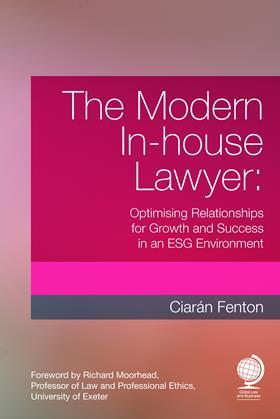What does a business need from the legal function? This is a frequent topic at legal conferences. Usually, a chief executive is wheeled in to answer this question. Why? The answer to me is obvious: the relationship is one of employer-employee first, lawyer second.

The extent to which lawyers ask rather than tell their employers what they need varies from lawyer to lawyer. Nevertheless, frequently the culture of in-house functions is to attach its identity to the extent to which it is pleasing its employer. The evidence for this is illustrated in the list of topics at in-house conferences. This culture is neither good for the legal function nor for the employer-client.
But it is possible using this model to reframe the relationship within an employee-employer dynamic.
The key step is for the legal function to understand the purpose, strategy, and behaviour plan (PSB) of the organisation in sufficient detail to tell, not ask, the organisation what it needs to achieve that PSB.
Then it must cost these needs fully. Let’s say your legal function decides your employer client needs 10 things and these cost $10, that you can back up this analysis and costing and demonstrate, not assert, the risks to the employer client of dropping any one of the 10 things. If the organisation provides a budget of only $7, then the legal function must do seven things, not 10, and the organisation must understand the risks of not paying for the three.
If the legal function does 10 things, it is performing what some in the legal profession describe as a diving catch – a cricket term - to do what has become a dangerous but popular catchphrase in the profession: doing more for less. As if they had been doing less for more all along. Confusing purpose with efficiency hurts everyone.
The final step in reframing the relationship between the in-house legal function and its employer client is for in-house lawyers to defy their law school training when it comes to leadership processes. Law schools don’t value leadership because law firms don’t value it, because they can’t bill it by the hour and because legal training eschews feelings. In-house lawyers must accept that one of their number – the General Counsel – is the CEO of the legal function and must lead, and they must submit to that leadership. It’s an action, not a thought.
Lawyers-as-leaders must:
- Create an environment in which the people they lead thrive: some lawyers-as-leaders struggle with this. They are often litigators trained not only to win, but also to ensure that the other side loses. The notion that they might help someone else win does not compute. It’s counterintuitive. That’s why GCs must pay more attention than they think to leadership development – their own, particularly.
- Grow and develop the function they lead: GCs must develop the legal function as a business because they are spending someone else’s money.
- Serve stakeholders – all of them, not just some: These include the court, society, the employer-client represented by its board, employees and suppliers. People died in trenches to allow lawyers to practise in a democracy. Society expects lawyers to bear society in mind when advising their employer clients. This expectation will intensify as businesses realise that ESG decision making is here to stay. It’s not a fad. Regulators are slowly waking up to this reality.
GCs and lawyers-as-leaders might consider taking the advice of Warren Buffet’s associate Charlie Munger: 'Never, ever think about something else when you should be thinking about the power of incentives.' He was not just referring to financial incentives. Lawyers-as-leaders need to consider soft incentives for those they lead. Leading is a verb – an action. Lawyers who lead must lead.
How do we get there? Consider the 10/20/70 rule of change: 10% are stars - celebrate them…20% are resisters - ignore or sack them…70% are on the fence – woo them. Our colleague Jenifer Swallow and the 33 in-house lawyers she led to sign the letter of complaint/plea to the Solicitors Regulation Authority could usefully use this rule in their quest to change the in-house profession. There are 34,500 in-house lawyers - and 10% of these is only 3,450 in-house lawyers who surely would back their letter publicly, if asked. Then that would constitute the beginnings of a movement and they could woo the 70% off the fence. Ask the 10% to support The 33 and watch things change.
I believe 3,450 in-house lawyers – just 10% of the total – coming together would change everything.

Ciarán Fenton is author of The Modern In-house Lawyer: Optimising Relationships for Growth and Success in an ESG Environment (published by Globe Law and Business), from which this is an edited extract































4 Readers' comments